Physical Address
304 North Cardinal St.
Dorchester Center, MA 02124
The midface is a complex skeletal framework that is composed principally of the maxilla and zygoma. Structural support is provided by a set of horizontal and vertical pillars ( Fig. 7.1 ). The main horizontal buttresses are the maxillary alveolus and the infraorbital rim, while the vertical buttresses are the nasomaxillary and the zygomaticomaxillary buttress. Defects of the midface are reconstructed by bony restoration of these buttresses which provide a base for dental implant placement, orbital floor reconstruction, and nasal airway preservation. Furthermore, aesthetics of the midface are maintained by reestablishing facial width, height, and projection.
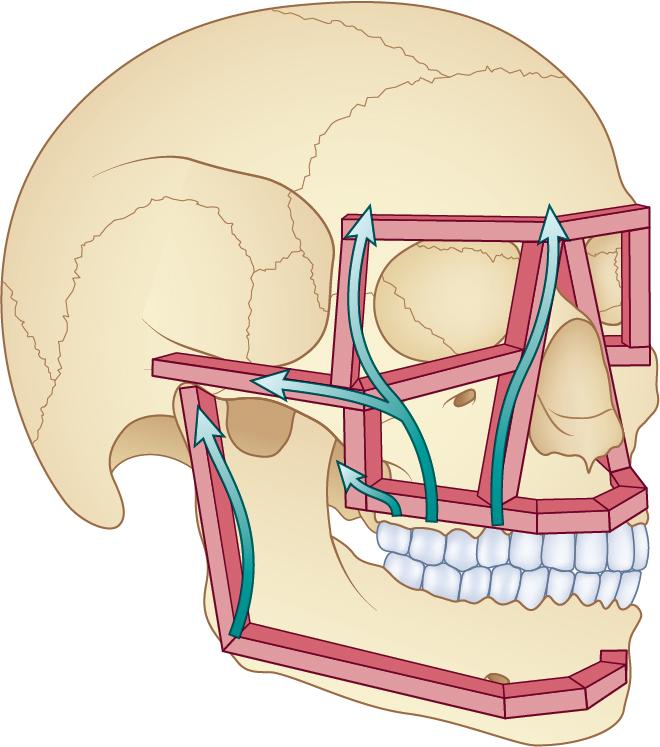
The midface can be conceptualized as a hexahedron with six walls ( Fig. 7.2 ). The roof is the orbital floor (infraorbital rim buttress), the floor is the alveolus and palate (maxillary buttress), the medial wall is the outer border of the nasal cavity (nasomaxillary buttress), and the lateral wall is the zygomaticomaxillary buttress. One of the earliest classifications of oncologic maxillary resections is based on an imaginary line from the medial canthus to the angle of the mandible (Ohngren’s line). Resections below this line are called infrastructure maxillectomies and those above this line are called suprastructure maxillectomies. More comprehensive classification schemes have since been described, the most commonly used of which are the Cordeiro and Brown systems ( Figs. 7.3 and 7.4 ). ,
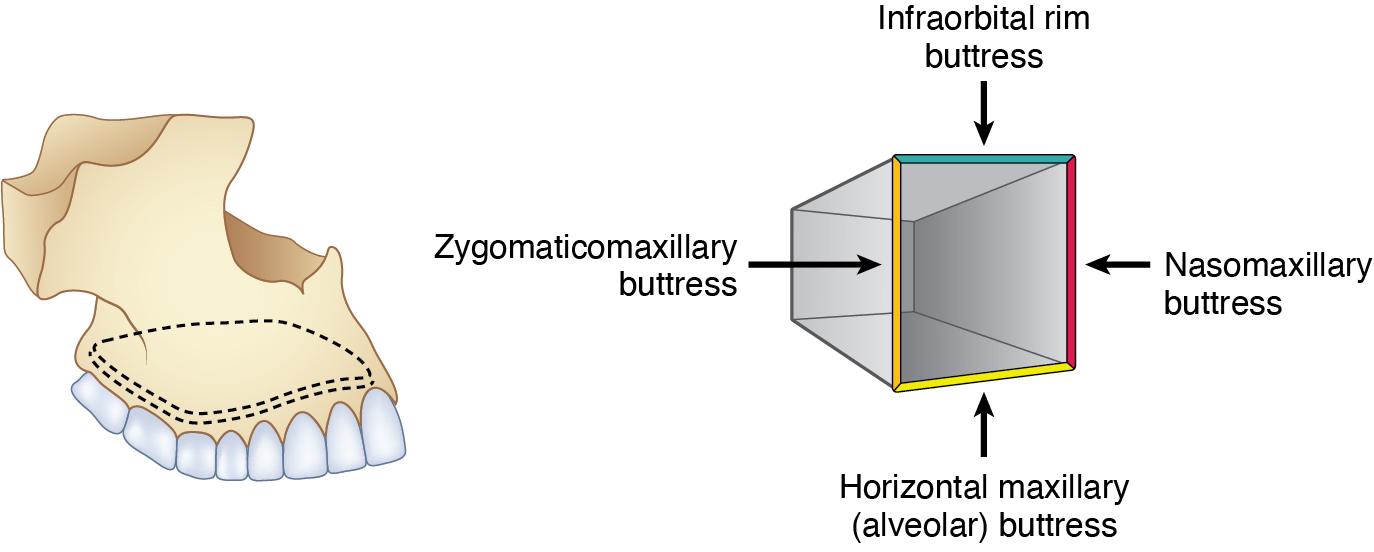
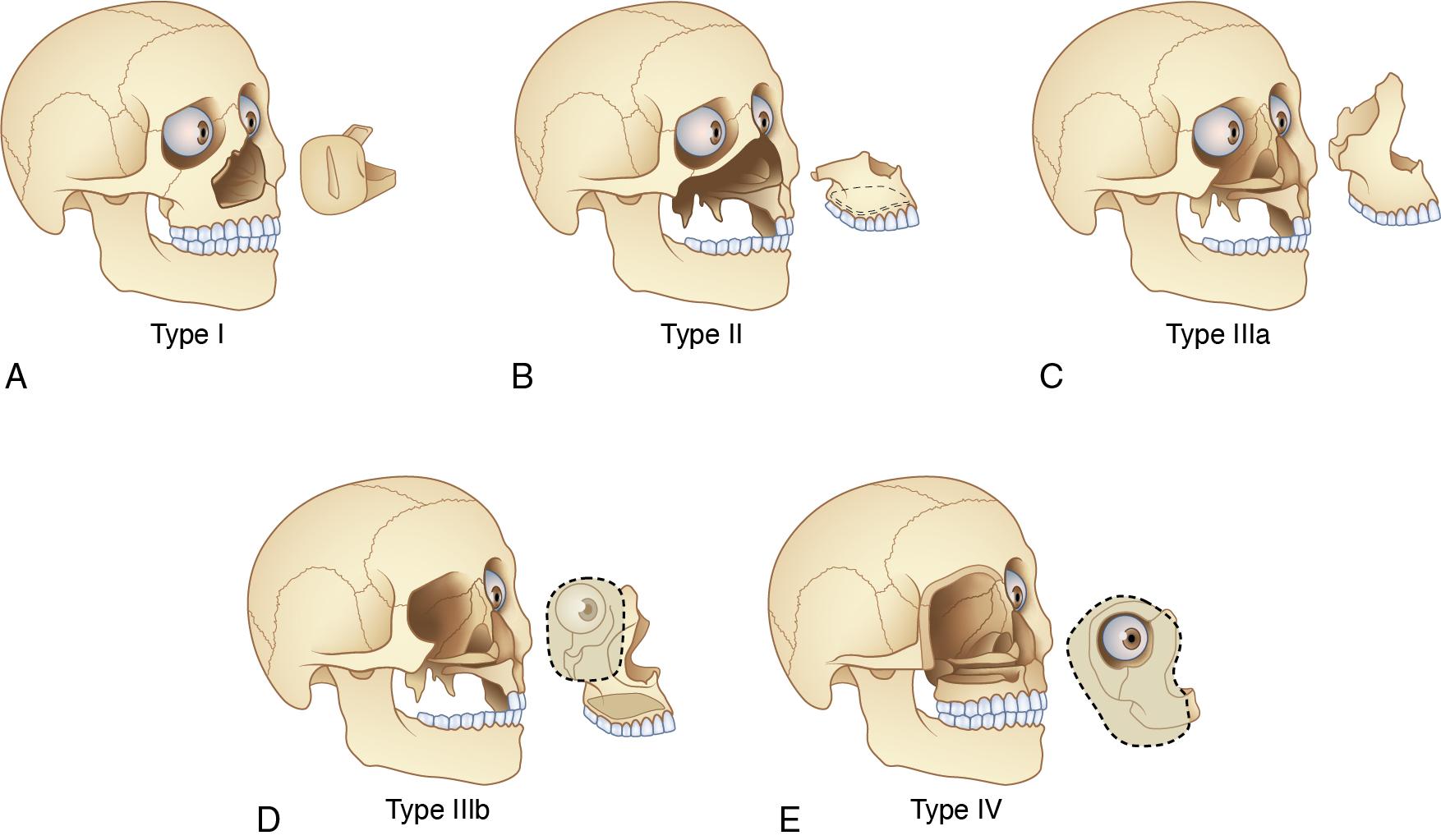
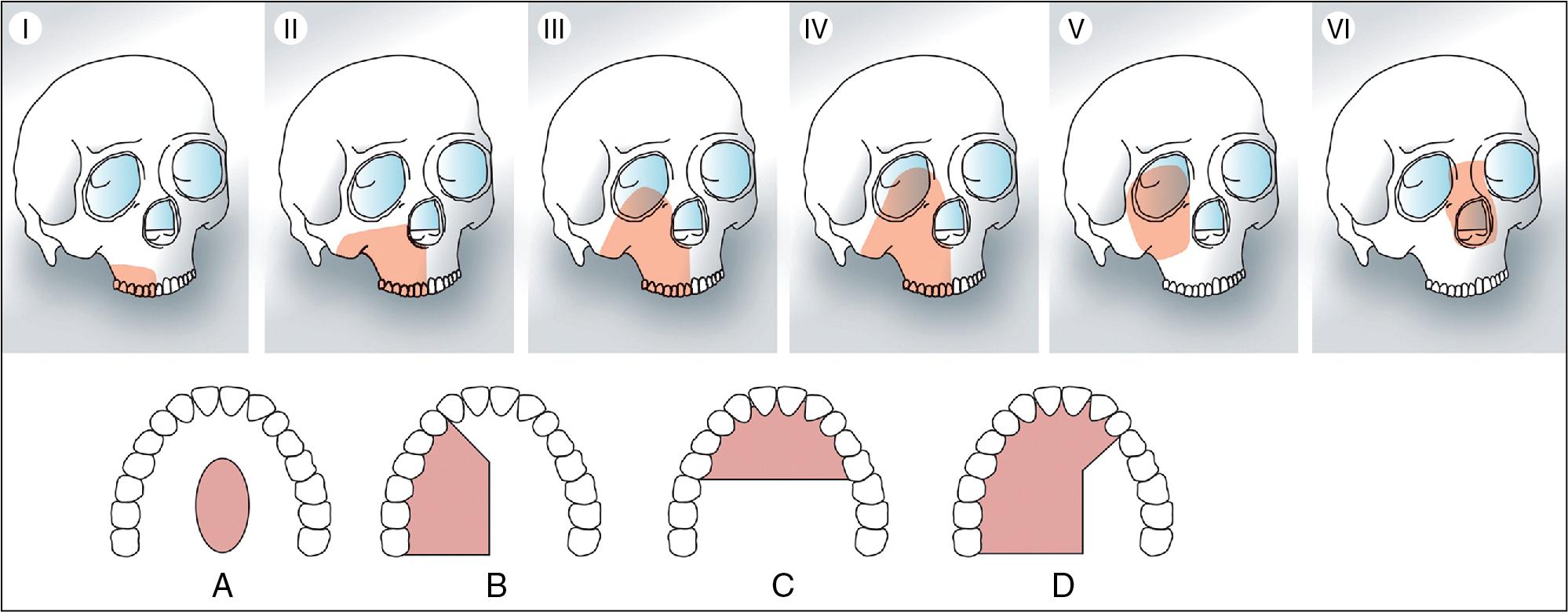
Maxillary reconstruction is a challenging undertaking. There is very limited working area and reduced exposure in the midface. Small bone segments have to fit in a tight space. Depending on defect type, complex geometric plate configurations may be needed. If multiple bone segments are needed (e.g., total maxillectomy), it is imperative that cuts be accurate; even a small change in the angulation of the osteotomies will affect the shape of the entire construct. Bone position needs to be in proper relation to the mandible for dental implants to be usable for prosthetic dental restoration. Accurate infraorbital rim reconstruction is essential to prevent lower lid malposition and create a platform for orbital floor reconstruction to prevent enophthalmos and hypoglobus. The midfacial bony framework also allows for optimal draping of soft tissue for prevention of orocutaneous and nasocutaneous fistulae.
Computer-assisted design/computer-assisted modeling (CAD/CAM) and three-dimensional (3D) printing technology allows creation of customized flap and plate designs that are specific to the defect and patient’s anatomy. It provides unlimited possibilities for designing complex osteotomies and plate configurations. This has decreased the traditionally steep learning curve for midface reconstruction resulting in accurate reconstructions that are reproducible across surgeons and centers. Computer-assisted surgery (CAS) is especially useful for delayed reconstruction in which there is no specimen to base the bone lengths and osteotomy angles on. Furthermore, there may be significant soft tissue contraction, making assessment of the original defect very difficult. One CAS technique to assist in delayed reconstruction is mirroring of the contralateral uninvolved maxilla onto the defect. For total maxillectomy defects there is no contralateral normal for mirroring; therefore, vendors can provide stock normative data of the midface during the CAS process. An alternative is to obtain a computed tomography (CT) scan of the patient with an obturator in place to provide information about the occlusal height and angulation.
A major advantage of CAS is the ability to place osseointegrated dental implants at the time of reconstruction. Implants can be positioned in a functionally favorable location and trajectory and optimal areas of fibula bone thickness. It also allows implants to be placed in non-radiated bone, thus reducing risk of wound healing complications and osteoradionecrosis. Placement of dental implants prior to radiation has higher rates of osseointegration than when implants are placed into irradiated bone. Primary implant placement has resulted in higher rates of dental rehabilitation, as traditionally a very small percentage of patients underwent delayed dental implant placement. Furthermore, it saves an extra operation for the patient.
CAD/CAM also allows fabrication of patient-specific hardware. Novel shaped plates can be designed, including extension arms in multiple planes, to capture buttresses for more stable fixation ( Fig. 7.5 ). A 3D printed plate also eliminates inaccuracies in contouring plates freehand and avoids screw hole distortion from trial-and-error bending. For delayed reconstructions where normal anatomy is distorted the printed plate serves as a useful reference to guide the construct position. Stereolithographic models can also be generated, and plates can be adapted to these models. Orbital floor reconstruction can be performed more accurately by fabricating custom orbital implants or bending titanium meshes on stereolithographic models. Obturators can also be fabricated using CAD/CAM technology. This simplifies the process for clinicians by decreasing the tedious hands-on work traditionally required with getting impressions. It thus increases patient comfort, especially for individuals with restricted mouth opening.
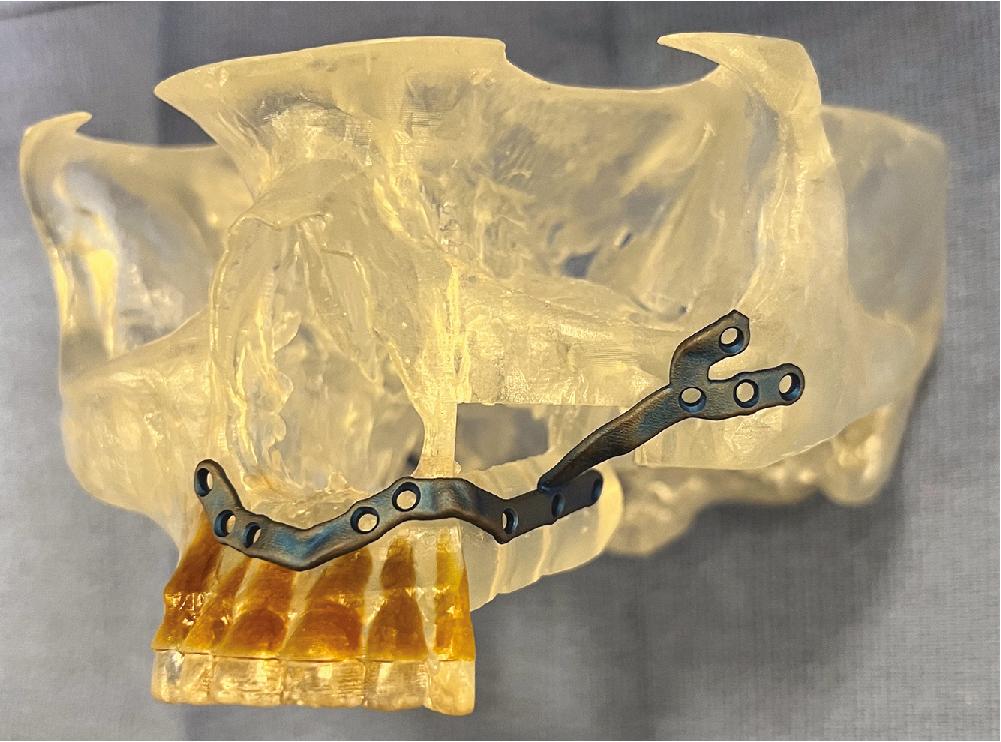
CAS can also help with tumor resection through the creation of osteotomy guides on the maxilla. In the compact and complex structure of the midface, it may be difficult to determine appropriate margins in the operating room. Computer imaging allows visualization of tumor in 3D, which can help better understand its spatial relationship to surrounding structures. Thus, accurate margin control may be obtained with the use of patient-specific cutting guides meanwhile preserving noninvolved structures.
Close communication with the ablative, reconstructive, and dental surgeons is critical for successful aesthetic and functional outcomes. The two most important reconstructive considerations are (1) the anticipated bony and soft tissue defect and (2) available donor sites. Tissue requirements are easier to predict in immediate reconstruction as opposed to secondary reconstructions, where there is soft tissue contracture which masks the true extent of tissue deficiency. A physical examination should be undertaken to assess all available donor sites.
Palatal obturators can be used for patients at high risk for free flaps or those who do not want to undertake the risks associated with reconstruction. They separate oral and nasal cavities to help with oral feeding and speech. Sufficient residual dentition is needed for prosthetic stabilization. Their big drawback is daily inconvenience and continued maintenance. Patient-specific obturators can be fabricated using CAS. Obturators may fail in the long-run in patients receiving radiation as the remaining dentition deteriorates and is no longer able to adequately retain the prosthesis.
Soft-tissue-only reconstruction can result in very good functional and aesthetic outcomes in unilateral posterior alveolar and palatal defects. The remaining dentition is sufficient for chewing. Defects with extensive soft tissue requirements can also be reconstructed with soft tissue as a first stage and then, if indicated, with bone at a second stage.
Bony reconstruction results in optimal maintenance of facial aesthetics by providing rigid support for soft tissue structures, minimizing their displacement and contraction long term and after radiation. It also allows for dental rehabilitation. The most commonly used bone flaps in midface reconstruction are the fibula, iliac crest, and scapula flaps. Each flap is uniquely advantageous for its bony and soft tissue attributes. The fibula is our flap of choice due to its multiple favorable attributes. It is a long tubular bone that can withstand multiple osteotomies, making it amenable to reconstruction of all types of defects. The skin paddle is adherent to bone, making it favorable for palatal resurfacing. The flexor hallucis longus muscle protects the pedicle and can fill dead space. The soleus muscle can be harvested in a chimeric fashion if a more extensive dead space filling is needed. The flap pedicle is also long and can reach neck vessels. The iliac crest flap provides a large block of bone that can be shaped to restore bony buttresses. The pedicle is short and therefore may require vein grafting. Alternatively, flap design can be shifted a little posteriorly on the iliac crest to gain some pedicle length. It is a good flap for hemimaxillary defects. The skin paddle is typically too thick in overweight individuals for palatal reconstruction. The internal oblique muscle can be used for intraoral lining. The scapula flap has the advantage of providing a large amount of skin and muscle that is independent of the bone, allowing flexibility in defects that have an extensive soft tissue component. The lateral border and tip of the scapula are used for bone, scapular or parascapular orientation for skin island, and latissimus and/or serratus for muscle. CAS allows bone designs of unlimited configurations, by orienting the bone in horizontal or vertical directions.
Standard photographs of the face and oral cavity are obtained at the initial patient visit. Photographs are also taken at postoperative visits. These should be taken under the same conditions to maintain uniformity. Patient photographs are critical for surgical planning and evaluation of outcomes.
Dental assessments are performed by the dental team. Impressions are obtained, which are used for fabrication of tooth-borne cutting guides. Alternatively, an intraoral scanner can be used for imaging the dentition.
The following is the workflow associated with CAD/CAM-based midface reconstruction.

Become a Clinical Tree membership for Full access and enjoy Unlimited articles
If you are a member. Log in here